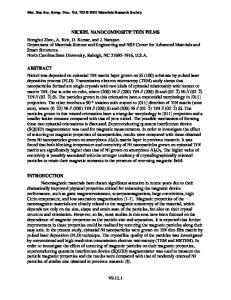Electrochromic Nickel Hydroxide Thin Films Chemically Deposited
- PDF / 182,850 Bytes
- 6 Pages / 612 x 792 pts (letter) Page_size
- 39 Downloads / 374 Views
0972-AA09-08
Electrochromic Nickel Hydroxide Thin Films Chemically Deposited Monica Araceli Vidales-Hurtado and Arturo Mendoza Unidad Queretaro, Cinvestav, Libramiento Norponiente 2000, Fracc. Real de Juriquilla, Queretaro, Mexico
ABSTRACT Nickel hydroxide thin films were deposited on ITO-coated glass substrates by the chemical bath deposition method. Two formulations using nickel nitrate were employed to obtain the films. The first one is through coordination compounds by using an ammonia complex producing the well crystallized phase β(II)-Ni(OH)2. The second formulation is based on the decomposition of urea at temperatures above of 90 °C, which promotes the deposition of the turbostratic phase α(II)- Ni(OH)2. After thermal annealing in air at temperatures of 250-300 °C, the β(II) films retain their polycrystalline structure, while the α(II) films are partially transformed to NiO. The electrochromic behavior of the films was tested by cyclic voltammetry in a three electrodes configuration cell. Also, chronoamperometry and in-situ single wavelength transmittance measurements were carried out to evaluate the switching time response. From Raman spectroscopy the structural transformations between colored and blanched states were studied. In the colored state most of the films show a mixture of β(III) and γ(III) phases of NiOOH, and in one case the Ni2O3 phase was found. It is shown that the films can exhibit high optical contrast depending on the processing conditions and electrical potential applied. INTRODUCTION Nickel oxide based thin films for electrochromic applications are of current interest because their high coloration efficiency. Physical and chemical methods like sputtering, pulsed laser deposition, spray pyrolysis, sol-gel, electrodeposition, and chemical precipitation, have been employed to obtain films exhibiting electrochromism [1-5]. Depending on the method, specific conditions during deposition and post-deposition processing, different electrochromic behavior has been reported. Among bleached phases are NiO and Ni(OH)2, while colored phases include Ni2O3 and NiOOH. However, in some cases, it has been difficult to resolve what phases are responsible during switching. Although the chemical bath deposition method has been successfully used to obtain chalcogenide based semiconductors and other compounds, to the date there are only a few reports about its application to obtain nickel oxide based films with electrochromic properties [6-8]. In this work we show that the chemical bath deposition method is promissory to obtain nickel hydroxide films for electrochromic applications. For that, different formulations with variable composition in solution and post-annealing treatment have been tested in the study of the electrochromic behavior of the films and several parameters like modulation in transmittance, coulometric capacity, and response time, are evaluated.
EXPERIMENTAL DETAILS Two methods were employed to obtain homogeneous and transparent Ni(OH)2 thin films using nickel nitrate. In the first method,
Data Loading...











